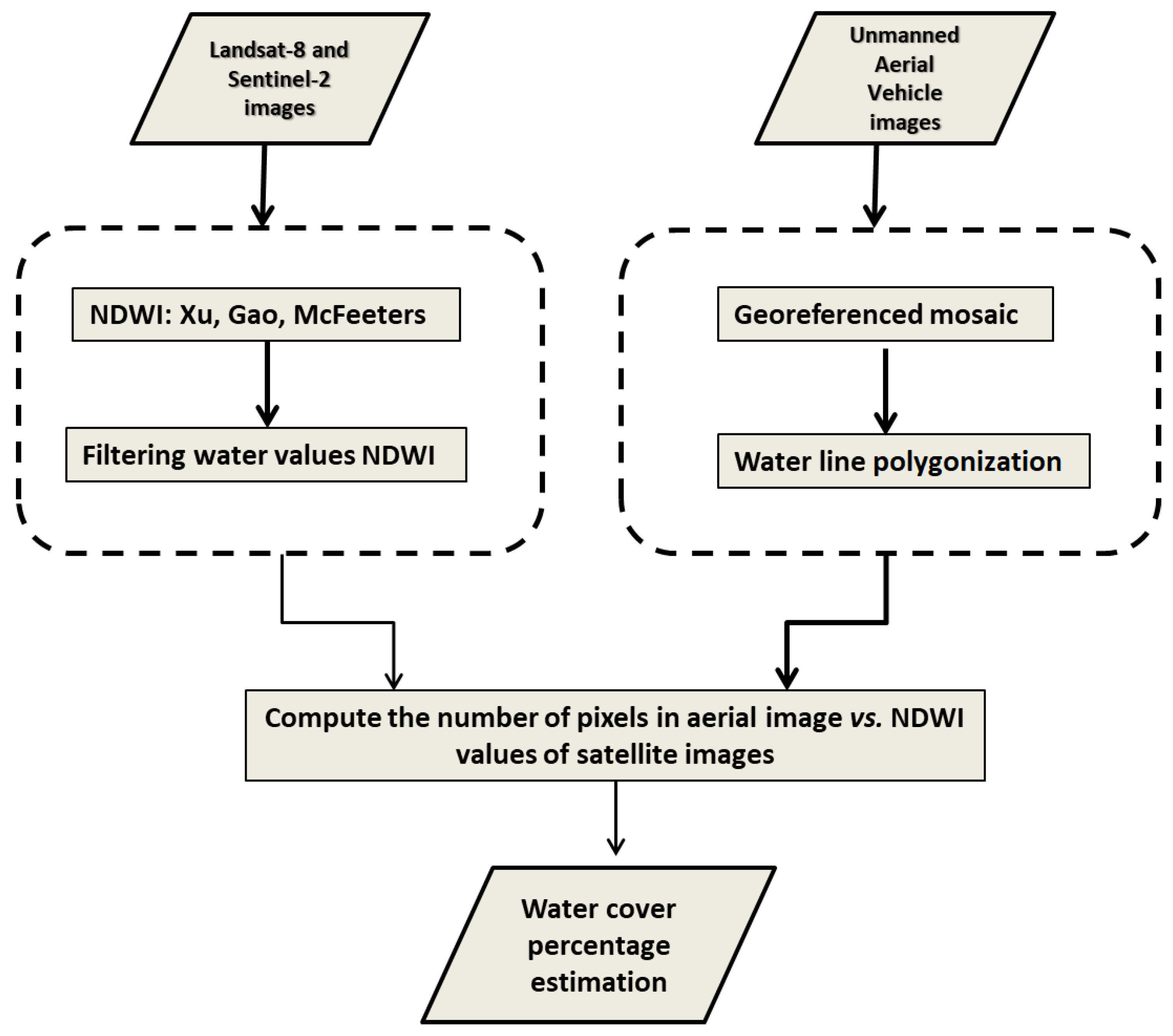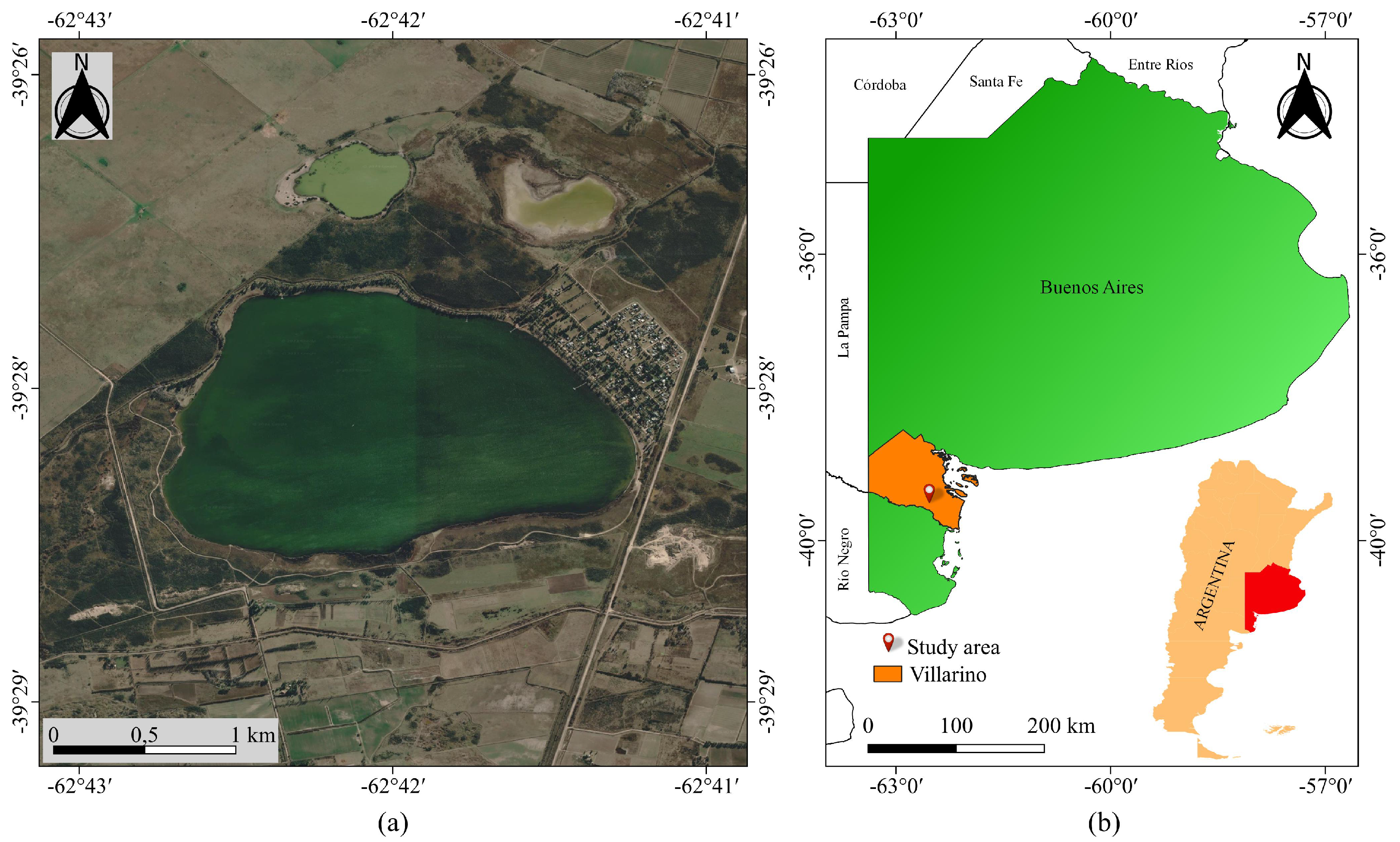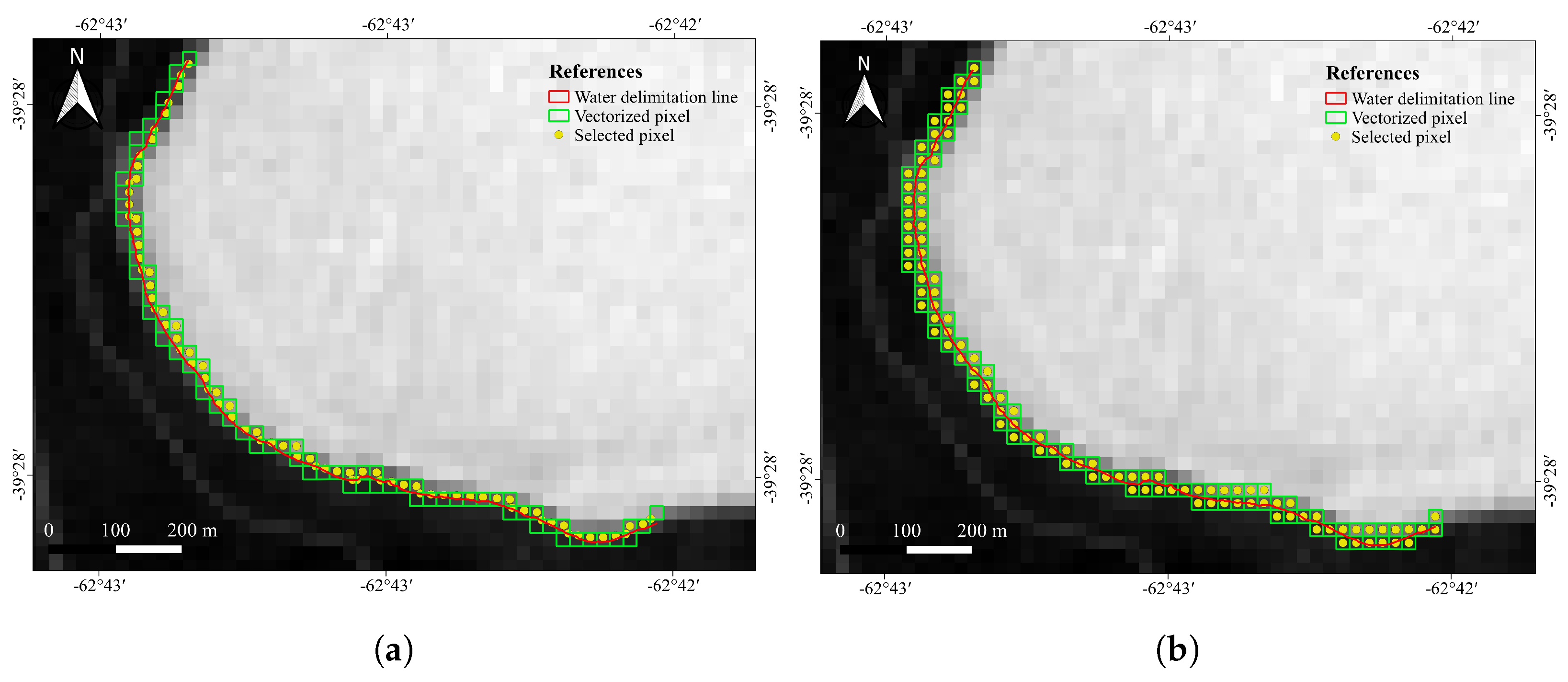Assessment of Landsat-8 and Sentinel-2 Water Indices: A Case Study in the Southwest of the Buenos Aires Province (Argentina)
Abstract
:1. Introduction
2. Materials and Methods
2.1. Study Area and Sample Preparation
2.2. Data Acquisition
2.3. Data Processing
- 1.
- The lagoon shoreline is segmented by specialist geographers over the ground truth mosaic (Figure 3). The resulting shapefile is overlapped over the registered Landsat-8 and Sentinel-2 images to establish a set of boundary pixels in each satellite image.
- 2.
- Different NDWI models are computed using L8 and S2 images specifically for the mixed pixels, i.e., those arising over the vectorized shoreline using two different criteria (nearest neighbor and linear reconstruction).
- 3.
- Actual water cover percentage over the satellite mixed pixels is estimated with the ground truth mosaic, and the correspondence of these percentages with the corresponding NDWI values are represented together.


3. Results
3.1. Landsat-8 and Sentinel-2 Zero-Order Criterion
3.2. Landsat-8 and Sentinel-2 First-Order Criterion
4. Discussion and Conclusions
Author Contributions
Funding
Institutional Review Board Statement
Informed Consent Statement
Data Availability Statement
Conflicts of Interest
References
- Feyisa, G.L.; Meilby, H.; Fensholt, R.; Proud, S.R. Automated Water Extraction Index: A new technique for surface water mapping using Landsat imagery. Remote Sens. Environ. 2014, 140, 23–35. [Google Scholar] [CrossRef]
- Kuenzer, C.; Guo, H.; Huth, J.; Leinenkugel, P.; Li, X.; Dech, S. Flood Mapping and Flood Dynamics of the Mekong Delta: ENVISAT-ASAR-WSM Based Time Series Analyses. Remote Sens. 2013, 5, 687–715. [Google Scholar] [CrossRef]
- Nair, P.K.; Babu, D.S. Spatial Shrinkage of Vembanad Lake, South West India during 1973–2015 using NDWI and MNDWI. Int. J. Sci. Res. 2016, 5, 319–7064. [Google Scholar]
- Islam, A.S.; Bala, S.K.; Haque, A. Flood inundation map of Bangladesh using MODIS surface reflectance data. In Proceedings of the International Conference on Water and Flood Management (ICWFM), Dhaka, Bangladesh, 15–17 March 2009; pp. 739–748. [Google Scholar]
- Islam, A.; Bala, S.; Haque, M. Flood inundation map of Bangladesh using MODIS time-series images. J. Flood Risk Manag. 2010, 3, 210–222. [Google Scholar] [CrossRef]
- Pekel, J.F.; Vancutsem, C.; Bastin, L.; Clerici, M.; Vanbogaert, E.; Bartholomé, E.; Defourny, P. A near real-time water surface detection method based on HSV transformation of MODIS multi-spectral time series data. Remote Sens. Environ. 2014, 140, 704–716. [Google Scholar] [CrossRef]
- McFeeters, S. Using the Normalized Difference Water Index (NDWI) within a Geographic Information System to Detect Swimming Pools for Mosquito Abatement: A Practical Approach. Remote Sens. 2013, 5, 3544–3561. [Google Scholar] [CrossRef]
- Chris Neigh, Landsat Science. Available online: https://landsat.gsfc.nasa.gov/about/ (accessed on 23 June 2023).
- Bie, W.; Fei, T.; Liu, X.; Liu, H.; Wu, G. Small water bodies mapped from Sentinel-2 MSI (MultiSpectral Imager) imagery with higher accuracy. Int. J. Remote Sens. 2020, 41, 7912–7930. [Google Scholar] [CrossRef]
- Frazier, P.S.; Page, K.J. Water body detection and delineation with Landsat TM data. Photogramm. Eng. Remote Sens. 2000, 66, 1461–1468. [Google Scholar]
- European Space Agency, about Sentinel Online. Available online: https://sentinel.esa.int/web/sentinel/missions/sentinel-2 (accessed on 25 June 2023).
- Hashim, B.M.; Sultan, M.A.; Attyia, M.N.; Al Maliki, A.A.; Al-Ansari, N. Change Detection and Impact of Climate Changes to Iraqi Southern Marshes Using Landsat 2 MSS, Landsat 8 OLI and Sentinel 2 MSI Data and GIS Applications. Appl. Sci. 2019, 9, 2016. [Google Scholar] [CrossRef]
- Löw, M.; Koukal, T. Phenology Modelling and Forest Disturbance Mapping with Sentinel-2 Time Series in Austria. Remote Sens. 2020, 12, 4191. [Google Scholar] [CrossRef]
- Lasaponara, R.; Abate, N.; Fattore, C.; Aromando, A.; Cardettini, G.; Di Fonzo, M. On the Use of Sentinel-2 NDVI Time Series and Google Earth Engine to Detect Land-Use/Land-Cover Changes in Fire-Affected Areas. Remote Sens. 2022, 14, 4723. [Google Scholar] [CrossRef]
- Kaire, T.; Tiit, K.; Alo, L.; Margot, S.; Birgot, P.; Nõges, T. First experiences in mapping lake water quality parameters with Sentinel-2 MSI imagery. Remote Sens. 2016, 8, 640. [Google Scholar]
- Xiucheng, Y.; Shanshan, Z.; Xuebin, Q.; Na, Z.; Ligang, L. Mapping of urban surface water bodies from Sentinel-2 MSI imagery at 10 m resolution via NDWI-based image sharpening. Remote Sens. 2017, 9, 596. [Google Scholar]
- Van der Meer, F.D.; Van der Werff, H.M.A.; van Ruitenbeek, F.J.A. Potential of ESA’s Sentinel-2 for geological applications. Remote Sens. Environ. 2014, 148, 124–133. [Google Scholar] [CrossRef]
- Alfonso, M.B. Estructura y Dinámica del Zooplancton en una Laguna con Manejo Antrópico: Laguna La Salada (Pedro Luro, Pcia. de Buenos Aires). Ph.D. Thesis, Universidad Nacional del Sur, Bahía Blanca, Argentina, 2018. [Google Scholar]
- Diovisalvi, N.; Bohn, V.Y.; Piccolo, M.C.; Perillo, G.M.; Baigún, C.; Zagarese, H.E. Shallow lakes from the Central Plains of Argentina: An overview and worldwide comparative analysis of their basic limnological features. Hydrobiologia 2015, 752, 5–20. [Google Scholar] [CrossRef]
- Fornerón, C.F.; Bohn, V.Y.; Piccolo, C.M. Variación del área de la laguna la salada en relación al régimen pluviométrico de la región. Contrib. Científicas GAEA—Soc. Argent. Estud. Geográficos 2008, 20, 109. [Google Scholar]
- McFeeters, S.K. The use of the Normalized Difference Water Index (NDWI) in the delineation of open water features. Int. J. Remote Sens. 1996, 17, 1425–1432. [Google Scholar] [CrossRef]
- Xu, H. Modification of normalised difference water index (NDWI) to enhance open water features in remotely sensed imagery. Int. J. Remote Sens. 2006, 27, 3025–3033. [Google Scholar] [CrossRef]
- Gao, B.C. NDWI—A normalized difference water index for remote sensing of vegetation liquid water from space. Remote Sens. Environ. 1996, 58, 257–266. [Google Scholar] [CrossRef]
- Condeça, J.; Nascimento, J.; Barreiras, N. Monitoring the storage volume of water reservoirs using Google Earth Engine. Water Resour. Res. 2022, 58, e2021WR030026. [Google Scholar] [CrossRef]









Disclaimer/Publisher’s Note: The statements, opinions and data contained in all publications are solely those of the individual author(s) and contributor(s) and not of MDPI and/or the editor(s). MDPI and/or the editor(s) disclaim responsibility for any injury to people or property resulting from any ideas, methods, instructions or products referred to in the content. |
© 2023 by the authors. Licensee MDPI, Basel, Switzerland. This article is an open access article distributed under the terms and conditions of the Creative Commons Attribution (CC BY) license (https://creativecommons.org/licenses/by/4.0/).
Share and Cite
Santecchia, G.S.; Revollo Sarmiento, G.N.; Genchi, S.A.; Vitale, A.J.; Delrieux, C.A. Assessment of Landsat-8 and Sentinel-2 Water Indices: A Case Study in the Southwest of the Buenos Aires Province (Argentina). J. Imaging 2023, 9, 186. https://doi.org/10.3390/jimaging9090186
Santecchia GS, Revollo Sarmiento GN, Genchi SA, Vitale AJ, Delrieux CA. Assessment of Landsat-8 and Sentinel-2 Water Indices: A Case Study in the Southwest of the Buenos Aires Province (Argentina). Journal of Imaging. 2023; 9(9):186. https://doi.org/10.3390/jimaging9090186
Chicago/Turabian StyleSantecchia, Guillermina Soledad, Gisela Noelia Revollo Sarmiento, Sibila Andrea Genchi, Alejandro José Vitale, and Claudio Augusto Delrieux. 2023. "Assessment of Landsat-8 and Sentinel-2 Water Indices: A Case Study in the Southwest of the Buenos Aires Province (Argentina)" Journal of Imaging 9, no. 9: 186. https://doi.org/10.3390/jimaging9090186





